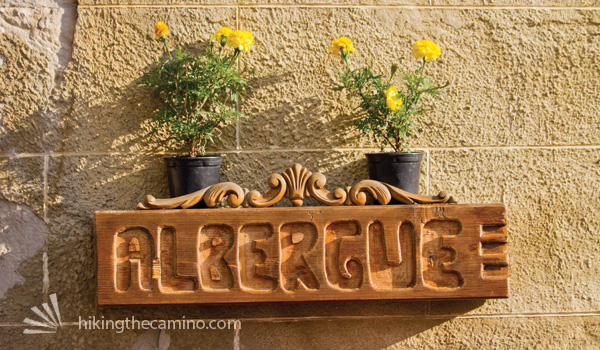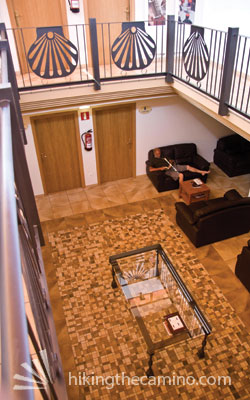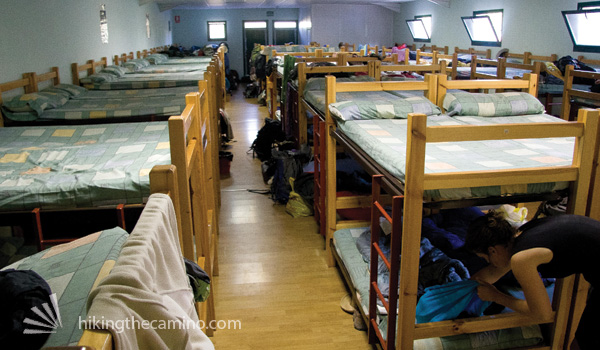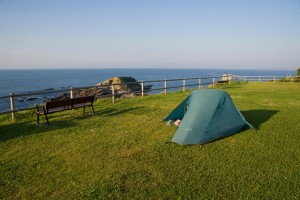Where to Sleep on the Camino
Accommodations are available on the Camino at a variety of budgets, from affordable dormitory beds to posh 5-star hotels.
- Pilgrim Albergues are the most convenient and economic choice, but bring your earplugs!
- Pensiones, Hostales, Casas Rurales and Hotels offer more privacy in a variety of prices ranges.
- Camping is not popular on the Francés route, though there are occasional camp grounds and some pilgrims choose to wild camp.

Albergues (Pilgrim Hostels)
The system of pilgrim hostels (known in Spanish as “albergues”) are a unique feature of the camino, especially the Camino Francés, which allow pilgrims to sleep in dormitory-style accommodations for arou d €8-20 per night. On the Francés route, these accommodations are very frequent, with as little as 5km between albergues and only a few stretches of up to 15km between albergues. Most albergues are offered on a “first come, first serve” basis and cannot be reserved in advance, with the exception of some private albergues. The person in charge of an albergue is known as the “hospitalero” (man) or “hospitalera” (woman), see below.
 There are several types of albergue available. Municipal albergues are sponsored by local government bodies and often staffed by volunteers. These are often the most inexpensive albergues, but are in varying stages of repair or disrepair and may not be the most comfortable. Some municipal albergue are housed in former schoolhouses or other repurposed buildings. Overflow in the busy summer months can sometimes be accommodated in public sports buildings known as “polideportivos” in Spanish.
There are several types of albergue available. Municipal albergues are sponsored by local government bodies and often staffed by volunteers. These are often the most inexpensive albergues, but are in varying stages of repair or disrepair and may not be the most comfortable. Some municipal albergue are housed in former schoolhouses or other repurposed buildings. Overflow in the busy summer months can sometimes be accommodated in public sports buildings known as “polideportivos” in Spanish.
Parochial albergues are operated by religious institutions such as monasteries, convents or local churches. They tend to be simple, but offered with a lot of care by volunteer caretakers. Many of these accommodations are offered on a donation basis (donativo) or for a low fixed price.
Association albergues are operated by various pilgrim associations from around the world. They are often staffed by volunteers who have done the Camino before so have a good sense of what pilgrims need. Association albergues are supplemented by donations, so are often offered on a donation basis or a low fee.
Private albergues are owned and run by private individuals or group. Private albergues often offer more comfortable accommodations with “extra” offerings such as meals, wash/dryer, internet, wifi, etc. While the price is sometimes higher (average €12-15 per night), the satisfaction of supporting a local business is priceless. Some private albergues are owned by former pilgrims and have a cozy feel, others have more of an impersonal hotel feel. Some private albergues have banded together to form a network with certain standards, these are known as “network albergues.”
Hospitalero/a
This is the Spanish term for the person in charge of an albergue. This position can be staffed by a local Spaniard, international volunteers, nuns, and monks, often staying for a few weeks or months. Be polite and express gratitude to hospitalero/as whenever possible and respect rules even if they don’t make sense to you. It’s a tiring job, so it’s no wonder that most pilgrims have at least one experience of a grouchy or dogmatic hospitalero/a. A popular maxim posted in some albergues is: El turisto exige, el peregrino agradece. (“The tourist demands, the pilgrim appreciates.”)
Hotels
Most town along the Camino also have hotels or other private (not dormitory) accommodations. These range in price from simple fondas (rooms, often run by the local cafe/bar), to pensions (simple rooms in local family’s homes, sometimes with shared bathrooms), to hostales (family-run hotels), up to hotels and the expensive paradors (restored historic buildings that have been converted into luxury hotels).
A simple private room can be as inexpensive as €20-25 for a single room, and €25-30 for a double room. See our extensive list of accommodations along the Camino for specific accommodations and pricing. While more expensive than albergue dormitory accommodations, the occasional night of sleep in a private room can be necessary to keep your spirits high and your body well-rested, while also supporting local business.
 View hotels on the Camino de Santiago with websites and online booking
View hotels on the Camino de Santiago with websites and online booking
Camping
With the extensive network of inexpensive pilgrim albergues, camping is really not necessary along the main Camino de Santiago routes.
Legitimate campsites with showers and services are often located quite far off route and usually cost more than albergues per night! While it is possible to “stealth camp” in natural areas, most people utilize the albergue system. It’s hard to beat €5-10 for a hot shower and bed! If you are adamant about camping, consider carrying a very lightweight tent (we recommend Tarp Tent), sleeping pad (for warmth and comfort), and sleeping bag with an appropriate warmth rating to your hiking season.
Campsites should always be 120m/200ft away from roads, walking trails, water sources, towns/inhabited areas and historical sites. If you choose to rinse off or rinse your clothing in any natural water sources, such as rivers, lakes or streams, please do not use any soap as it may contaminate the water and be unhealthy for wildlife (even biodegradable soap). Camping will be easier if you speak some Spanish and can ask for permission to camp in a given area.
Hand Washing Clothes
While an increasing number of albergues offer the option of a machine washer, you will at least occasionally need to wash some clothing by hand. Most albergues have large sinks for laundry, sometimes with a bumpy scrubbing board that you can press clothes against to agitate.
First, fill the sink with warm water and add some detergent. Put your dirty clothes in and knead them against each other like kneading bread. If there is a scrubbing board, rub each item vigorously against the board. Next, drain the sink and refill with clean water. Agitate clothing again. Repeat until no more soap suds emerges.
Wring out each item thoroughly and place on the line to dry. Some albergues supply clothespins but its a good idea to have a few of your own or to use safety pins. Be sure to take your clothing off as soon as they have dried to make room for others’ items; Also be careful to only take off your own clothes and not to to accidentally take any items that resemble your clothes but belong to someone else.
In persistent wet and cool weather clothes may have difficulty drying, and you’ll be thankful for the industrial washer/dryer machines in many albegues. Consider sharing a full load with other pilgrims to save money and resources.

Albergue Etiquette
The first rule of albergue etiquette is respect; Respect your fellow pilgrims and the hospitalero.
Below are some guidelines of classic pilgrim complaints.
- Don’t pack items in plastic grocery bags, which are very noisy if you are rustling through your bag late at night, early in the morning, or during someone’s afternoon nap. Cloth stuff sacks are much quieter.
- Respect albergue curfews. Lights out is generally 10pm. If you plan on rising very early, have your things ready the night before for minimal noise in the morning.
- If you are a notorious snorer, please make every effort to sleep in a position that will minimize your noise. Consider staying in private accommodations for the sake of your fellow pilgrims. Some albergues have a special “snorers’ room” if you ask.
- If you must set an alarm, make sure it is very quiet and at a convenient place where you can turn it off very quickly. (One morning we were awakened by a noisy cell phone alarm, which did not wake up the owner. When he finally woke up, he had to rummage through his bag for several minutes before finding the offending phone.)
- Always be quiet in the sleeping area. Even in the afternoon, many pilgrims are trying to rest. Have your conversations elsewhere. Don’t talk on your cell phone in the dormitory area.
- When using the kitchen, prepare a quick and easy dish that requires minimal burners so that other have the opportunity to cook as well. Clean up after yourself promptly.
- In the sleeping area, don’t spray anything with a strong smell or apply stinky ointments, lance gross blisters, etc. Remember that some people have allergies and smell sensitivity.
- Once laundry is dry, remove it promptly from the wash line to make room for others.
- If you have a bottom bunk and see an older or injured person struggling to use a top bunk, consider offering them your more convenient bed.
- Never place your backpack on the bed. Some albergues have signs to this effect, and this is a prime way that bedbugs spread.
- Consistently keep valuables in a secure place to avoid the possibility or accusation of theft, or the stress of misplacing it.
- Clean up after yourself, and be environmentally responsible by disposing of garbage in the appropriate recycling bin.
Don’t expect anyone else to follow these rules. Be prepared to forgive others again and again for disturbing the silence, for making a mess, and for being gross. Instead of hostility or judgment, offer them kindness and empathy. The Camino is a great place to practice non-attachment and forgiveness. (thanks Jennifer Hofmann!)

Bed Bugs
Bed bugs, or Cimex lectularius, a blood-sucking parasitic insect, are on the rise around the world and have been a problem in accommodations along the Camino in recent years. Not only albergue dormitories are affected, but even 5-star hotels are not immune from the scourge. While bed bugs do not carry any known diseases, bites can be very uncomfortable and cause painful rashes in some people, and the insects are very difficult to get rid of once infested. One way to lower the risk of being bitten by bedbugs is to treat your sleeping bag and backpack with Permethrin, an insect repellent that binds to the cloth and lasts up to six weeks, even through laundering. You can also get a pre-treated bag liner, such as Sea to Summit Sleeping Bag Liner with Insect Shield. Avoid placing your backpack on your bed.
Bedbugs are about 4mm (1/4 in) long, 2.5mm wide and a reddish-brown color. Bedbugs are notorious hitchhikers, and pilgrims are ideal unwitting vehicles to spread infestation along the camino. Albergues are increasingly being fumigated for insects, so you may ask to see a certification of recent fumigation if you want to be sure. To check for bedbugs, feel along the seams of the mattress, as this is where the insects often hide during the day. Other signs of bugs include blood stains or tiny black spots (like poppy seeds or pen marks) which are bedbug excrement. Report any sign of bedbug activity to the hospitalero/a and look for another place to sleep!
If you do get bitten by bedbugs, assume that your belongings are carrying bugs and/or eggs. There are several ways to rid your belongings of bed bugs. Set out all your belongings on the grass and spray with Permethrin or other bug repellent that is effective for bed bugs. Let your items dry in the sun, then wash them in a washing machine with hot water and dry in a hot dryer. If you are in a larger city, you can take all your clothes, sleeping bag and pack to be dry cleaned. For fabric items that cannot be machine washed, spray with bug repellent and place in a ziplock bag, Spacesaver or other airtight bag for 24 hours, then hand wash in hot water.

